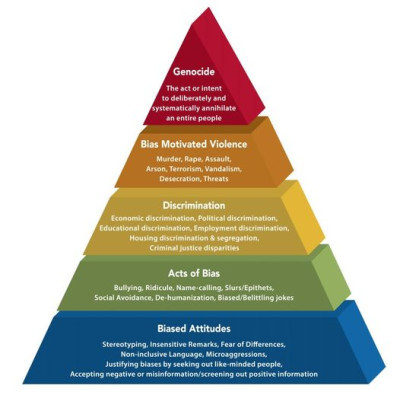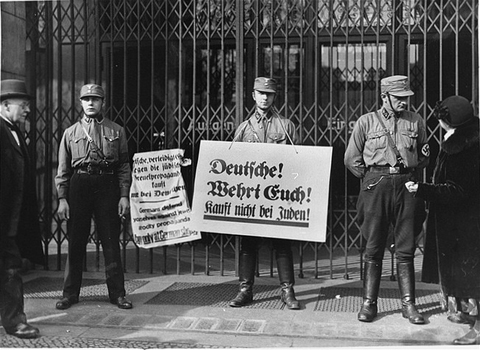



Source: Holocaust Centre for Humanity
One of the ways in which Hitler was able to gain power was by utilising and encouraging discrimination against different people in Germany and wider Europe, namely Jewish people. By using already existing biases he was appeal to appeal to people's hatred and fear to consolidate power and enact his plans. Read through the resources below to learn more about how Hitler used hate to gain power and how he codified it into law.
In this video, scholars discuss the events of Kristallnacht, a series of violent attacks against Jews in Germany, Austria, and part of Czechoslovakia in November, 1938.
On September 15, 1935, the Nazi regime announced two new laws:
These laws informally became known as the Nuremberg Laws or Nuremberg Race Laws. This is because they were first announced at a Nazi Party rally held in the German city of Nuremberg. Read through this article to learn more about these laws.
It was in Nuremberg, officially designated as the "City of the Reich Party Rallies," in the province of Bavaria, where Adolf Hitler and his Nazi Party in 1935 changed the status of German Jews to that of Jews in Germany, thus "legally" establishing the framework that eventually led to the Holocaust. Read through this article to learn more.
Violence was a crucial tool of the Nazi government, but its leaders were also eager to show that they were acting within the framework of the law. As they worked to consolidate power and reshape Germany according to their racial ideals, Nazi leaders passed a number of new laws that redefined citizenship and laid the groundwork for a “racial state.” Read through this website to learn more.
In his testimony for USC Shoah Foundation, Holocaust survivor Jack Arnel describes what he saw as a 12-year-old when the Nazis occupied Vilna, Lithuania in 1941. It is a clear example of how prejudice was used by the Nazis.
Read through this website to learn more about Hitler's ideologies about race and how he used stereotypes and bias to justify and enact unimaginable violence upon others.
It is evident from Mein Kampf and Hitler's speeches that he viewed racial conflict as the determining factor in all of human history. "The racial question gives the key not only to world history, but to all human culture."2 Race was not simply a political issue to be used to curry the favor of the masses, but the "granite foundation"3 of Hitler's ideology. Read through this article to learn more.
Racism fueled Nazi ideology and policies. The Nazis viewed the world as being divided up into competing inferior and superior races, each struggling for survival and dominance. They believed the Jews were not a religious denomination, but a dangerous non-European “race.” Nazi racism would produce murder on an unprecedented scale. Read through this website to learn more.
Prior to Hitler joining, the Nazi Party held extremely nationalist, racist and antisemitic views. After Hitler had joined the party, he expanded upon and marketed these ideas. Read through this website to learn more.
This article looks at how Hitler and the Nazis took inspiration from racist laws in the United States when creating their ideologies.
Nazism was “applied biology,” stated Hitler deputy Rudolf Hess. During the Third Reich, a politically extreme, antisemitic variation of eugenics determined the course of state policy. Hitler’s regime touted the “Nordic race” as its eugenic ideal and attempted to mold Germany into a cohesive national community that excluded anyone deemed hereditarily “less valuable” or “racially foreign.” Read through this article to learn more.
Hitler had outlined his ideas in Mein Kampf, from 1933 the implementation of these ideas affected many aspects of life in Germany. How did Nazi economic, social and racial policy affect life in Germany? Read through this website to learn more.
On November 9–10, 1938, Nazi leaders unleashed a series of pogroms against the Jewish population in Germany and recently incorporated territories. This event came to be called Kristallnacht (The Night of Broken Glass) because of the shattered glass that littered the streets after the vandalism and destruction of Jewish-owned businesses, synagogues, and homes. Read through this website to learn more.
During the first six years of Hitler’s dictatorship, government at every level—Reich, state and municipal—adopted hundreds of laws, decrees, directives, guidelines, and regulations that increasingly restricted the civil and human rights of the Jews in Germany. Read through this website to learn more.
The boycott of Jewish-owned businesses set the stage for another step in carrying out Adolf Hitler’s “racial” policies. People were whispering about the new plans for some time before they were made public on April 7, 1933. Read through this website to learn more.
After Adolf Hitler’s appointment as Chancellor in January 1933, government at every level—national, state, and municipal—began to adopt laws and policies that increasingly restricted the rights of Jews in Germany. A new law limited the number of Jewish students in any one public school to no more than 5 percent of the total student population. In 1933, 75 percent of all Jewish students attended general public schools in Germany. However, public schools also played an important role in spreading Nazi ideas to German youth. Educators taught students love for Hitler, obedience to state authority, militarism, racism, and antisemitism. In the face of increasing persecution at public schools, Jews in Germany turned increasingly to private schools for their children. Read through this website to learn more.

Adolf Hitler outlines his early views on ‘rational anti-Semitism’, in a September 1919 letter to Adolf Gemlich, a soldier in the Reichswehr. This letter is believed to be the oldest surviving document containing Hitler’s anti-Semitic beliefs
In December 1931, Heinrich Himmler signed the following order on marriages by members of the Schutzstaffel or SS. This policy was an attempt to maintain racial purity within the SS.

In April 1933 the Nazi propaganda chief Joseph Goebbels made some brief diary entries about the boycotts of Jewish businesses, which demonstrates how Nazi policies created discrimination against Jewish people.

The Law for the Protection of Hereditary Health was passed by the Reichstag in July 1933. It aimed to prevent anyone with a disability from having children by having them forcibly sterilised.

Dr Walter Gross was a German physician who oversaw the Office of Population Policy and Racial Welfare. In this speech from October 1934, Gross addressed a gathering of German women on Nazi eugenics policies.

William Zuckerman was a Jewish-American journalist, active in the early to mid-20th century. This article contains his views on the Nuremberg Laws and the formation of Jewish ghettos. It makes explicit the link between racist laws and the growth in hatred for Jews.

Adolf Hitler discusses and justifies the expulsion of Jews from Germany, from a speech given to the Reichstag in January 1939.

This front page of the Daily Express from 1938, reports a violent pogrom in Nazi Germany, known as 'Kristallnacht' (night of broken glass). In a single night, at least 91 Jews were killed, approximately 30,000 were arrested and sent to concentration camps, and thousands of Jewish homes, businesses and synagogues were attacked.
The article gives an accurate account of the events, but it misleadingly suggests that the violence was carried out by uncoordinated ‘gangs drunk with destruction’, and that the Nazis tried to maintain order. In reality, the violence and destruction was planned from the top of the Nazi regime. The assassination of Nazi diplomat Ernst vom Rath, a few days earlier, was used as an excuse for the actions, and detailed instructions were given to the secret police on how to carry out the pogroms.
As Kristallnacht is one of the first examples of orchestrated mass violence against the Jews, some historians consider it to be the start of the Holocaust. Others disagree and believe that the ‘Final Solution’, the plan to exterminate all Jewish people in Europe, was conceived later. Either way, after Kristallnacht there was an acceleration in the rate of anti-Semitic decrees. Just a matter of days after the violence, it was demanded that the Jews themselves pay one billion Reichsmarks for the damage caused on Kristallnacht.

The German government issues the Law for the Restoration of the Professional Civil Service (Gesetz zur Wiederherstellung des Berufsbeamtentums), which excludes Jews and other political opponents of the Nazis from all civil service positions. The law initially exempts those who had worked in the civil service since August 1, 1914, those who were veterans of World War I, or those with a father or son killed in action in World War I.
The German government also issues a new law concerning membership in the bar, which mandates the disbarment of non-“Aryan” lawyers by September 30, 1933. Exempted from this provision are Jewish lawyers practicing law since August 1, 1914, or Jewish lawyers who are German veterans of World War I.


 Conflict in Europe 1935-1945
by
Conflict in Europe 1935-1945
by
 Germany 1918-1945
by
Germany 1918-1945
by
 Hitler and Germany
by
Hitler and Germany
by
 Hitler and Kristallnacht
by
Hitler and Kristallnacht
by
 Maus : a survivor's tale
by
Maus : a survivor's tale
by
 Republic to Reich : a history of Germany 1918-1945
by
Republic to Reich : a history of Germany 1918-1945
by
 The rise and fall of the Third Reich : the illustrated chronicle of Hitler's life and times 1917-1945
The rise and fall of the Third Reich : the illustrated chronicle of Hitler's life and times 1917-1945
 Why did the rise of the Nazis happen?
by
Why did the rise of the Nazis happen?
by